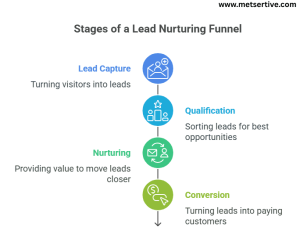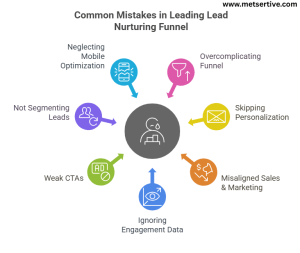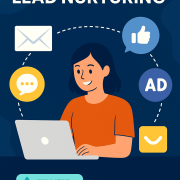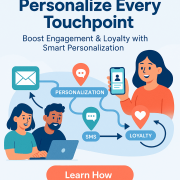How to Create a Lead Nurturing Funnel That Converts
If you’re tired of leads ghosting you after they download a freebie or attend a webinar, you’re not alone.
Most businesses think getting a lead’s email is the finish line. In reality, it’s just the starting point.
A lead nurturing funnel is your system for turning “sort-of-interested” prospects into ready-to-buy customers—without nagging or spamming. It’s the bridge between interest and decision.
And it works: Forrester reports that companies with effective lead nurturing generate 50% more sales-ready leads at a 33% lower cost. A clear lead nurturing strategy helps you systematically build trust while moving leads through your funnel.
In this guide, you’ll learn:
- What a lead nurturing funnel actually is (without the fluff)
- How to build a lead nurturing funnel
- The stages you need to guide leads toward buying
- Content to use at each step
- Tools to automate your funnel without overwhelm
- Mistakes to avoid so you don’t waste leads
Whether you’re running a B2B SaaS, e-commerce, or coaching business, you’ll walk away knowing how to build a funnel that doesn’t just collect emails—it converts them.
What Is a Lead Nurturing Funnel?
Imagine you walk into a store just to browse, and immediately, a salesperson says, “Want to buy this right now?”
You’d back away, right?
That’s what happens when you skip nurturing and go straight for the sale.
A lead nurturing funnel is your structured system to build trust and readiness across these stages:
- Awareness – Leads discover you through a blog, social post, or ad.
- Interest – They download a guide, sign up for a webinar, or engage with your content.
- Consideration – They evaluate if you’re the right fit, reading case studies or testimonials.
- Decision – They’re ready to take action: book a call, start a trial, or purchase.
Real-World Scenario:
A small HR SaaS platform was getting webinar signups but zero demo bookings. They realized their “follow-up” was a single email: “Book a demo now.”
They shifted to a nurturing funnel:
- Post-webinar thank-you email with a key takeaway.
- Follow-up email with a customer success story.
- A value email addressing a common HR pain point.
- Personalized email inviting them to book a call.
Result? Demo bookings increased by 47% within two months, and leads came into calls already warmed up.
Quick Tip:
Think of your funnel as dating, not speed dating. If your funnel asks for commitment before building trust, leads will bounce.
Lead Nurturing Funnel vs. Sales Funnel
While a sales funnel is the entire journey from stranger to customer, a lead nurturing funnel focuses on the “middle” stage—the critical period after someone opts in but before they purchase.
Your nurturing funnel’s job is to:
- Educate
- Overcome objections
- Build trust
- Keep your brand top-of-mind
so that when the moment is right, your lead says, “Yes, I’m ready.”
Why This Matters:
Without a structured lead nurturing funnel:
- Leads go cold because they don’t know what to do next.
- You lose potential customers to competitors who keep in touch.
- You waste ad spend on leads who drop off without converting.
With a nurturing funnel in place:
- You warm leads systematically.
- You convert higher-quality customers.
- You reduce your sales cycle.
Next:
Now that you know what a lead nurturing funnel is and why it’s the missing piece for your business, let’s dive into the core stages you need and how to build them step-by-step.
Core Stages of a Lead Nurturing Funnel
A lead nurturing funnel isn’t a one-email wonder. It’s a structured journey guiding your leads toward readiness without pressure. A nurturing funnel should be designed to convert marketing leads into sales qualified leads, ready for your sales team

Here’s how to break it down:
1️. Lead Capture
What it is: The moment you turn a visitor into a lead.
How:
- Lead magnets (eBooks, checklists)
- Webinar signups
- Free trials
- Newsletter opt-ins
Scenario:
A marketing consultant offers a “10-Step LinkedIn Content Checklist” in exchange for email addresses, turning visitors into warm leads.
Tip: Keep forms simple. More fields = fewer signups.
2️. Qualification
What it is: Sorting leads to focus on the best opportunities. Before nurturing leads, implementing a lead qualification process ensures you focus on the right prospects
How:
- Use lead scoring to track behavior (opens, clicks, visits).
- Segment based on interests or industry.
Scenario:
A SaaS company assigns +10 points when a lead visits the pricing page and +20 when they attend a webinar, indicating high interest.
Tip: Use CRM tools like HubSpot or Zoho to automate scoring
3️. Nurturing
What it is: Consistently providing value to move leads closer to a decision.
How:
- Email drip campaigns with education and social proof.
- Retargeting ads to re-engage website visitors.
- Social media touchpoints.
Scenario:
An HR software sends a 5-email drip campaign post-webinar:
- Thank you + webinar replay
- Related blog/resource
- Customer success story
- Overcoming a common objection
- Invite to book a call
Tip: Don’t rush to sell. Educate first, then offer solutions.
4️. Conversion
What it is: Turning leads into paying customers.
How:
- Personalized demo invites
- Free trial upgrades
- Consultation calls
- Clear CTAs on emails and landing pages
Scenario:
After nurturing, a lead books a call through a personalized invite that says, “Let’s map out your HR automation plan.”
Tip: Add a time-limited incentive (e.g., “Get your first month free if you book this week”) to encourage action.
Recap:
Your funnel stages should flow:
Lead Capture → Qualification → Nurturing → Conversion
When built intentionally, this funnel moves leads from “just curious” to “ready to buy” systematically.
Crafting Content for Each Funnel Stage
Now that you know the funnel structure, it’s time to feed it with the right content at each stage. Customer journey mapping allows you to align your funnel stages with your leads’ actual needs and questions at each step.”
1. Awareness (Top of Funnel)
Goal: Attract and educate.
Content:
- Blog posts
- Social media content
- Infographics
- Educational videos
Example:
A B2B SaaS company writes a blog, “5 Signs You Need Automated HR Processes,” to attract HR managers.
Tip: Add CTAs like “Download our HR Automation Checklist” to capture leads.
2. Interest (Mid Funnel)
Goal: Deepen engagement.
Content:
- Lead magnets (guides, checklists)
- Webinars
- Quizzes
Example:
A quiz, “How Efficient Is Your Hiring Process?”, collects emails while providing value.
Tip: Use quizzes to segment leads based on their needs automatically.
3. Consideration (Lower Mid Funnel)
Goal: Build trust and address objections.
Content:
- Case studies
- Testimonials
- Comparison guides
- Email drips with social proof
Example:
A SaaS sends an email with a mini-case study: “How Company X Reduced Turnover by 32% Using Our Software.”
Tip: Use client logos and testimonials in retargeting ads for credibility.
4. Decision (Bottom of Funnel)
Goal: Prompt action.
Content:
- Free trials
- Demo offers
- Consultations
- Time-sensitive offers
Example:
An HR tool sends a “Your Personalized Demo Awaits” email with a one-click booking link.
Tip: Use urgency carefully—pair it with value, not pressure.
Crafting the best email sequences for lead nurturing involves understanding your audience’s pain points and aligning content with funnel stages.
Putting It All Together:
Scenario:
1. A lead reads your blog → downloads your HR checklist (Awareness → Interest).
2. They receive a 5-part drip sequence with case studies and resources (Consideration).
3. They are invited to a free demo with a personalized CTA (Decision).
4. They convert and enter your customer onboarding flow.
Next Up:
You now know how to structure your lead nurturing funnel and feed it with content that matches your buyer’s journey.
Next, we will cover the best tools to automate your funnel so you can scale without dropping the ball.
Tools to Automate and Manage Your Lead Nurturing Funnel
Building a lead nurturing funnel is one thing. Running it manually? Impossible as you scale.
That’s where automation tools come in—Automated lead nurturing workflows save you time, maintain consistency, and ensure leads don’t slip through the cracks.
Here’s what you need in your tech stack:
1. CRM Platforms
Your CRM (Customer Relationship Management) tool is the brain of your funnel. It tracks leads, segments them, scores them, and aligns your sales and marketing teams. CRM lead tracking is critical for monitoring where each lead is within your funnel and tailoring your nurturing efforts.”
Examples:
- HubSpot: User-friendly, great for SMEs, integrates email, forms, and landing pages.
- Zoho CRM: Affordable, customizable, solid for small businesses.
- Salesforce: Best for advanced customization and larger teams.
Scenario:
A B2B SaaS uses HubSpot to automatically move leads who download a guide into a mid-funnel nurturing drip, while notifying sales when they visit the pricing page.
Tip: Use CRM tags to segment leads by funnel stage automatically.
2. Email Marketing Automation
Email is still your lead nurturing backbone. Use automation to send drip email sequences, segment lists, and personalize communication at scale. Well-timed drip email campaigns are the backbone of a high-converting lead nurturing funnel. Automated email follow-ups ensure your leads receive consistent value while freeing up your time.”
Examples:
- ActiveCampaign: Powerful automation workflows with CRM and lead scoring.
- Mailchimp: Great for simpler drips and broadcast emails.
- ConvertKit: Ideal for creators and coaches.
Scenario:
After a lead attends a webinar, ActiveCampaign sends a 5-part email series with case studies and a CTA to book a demo.
Tip: Use personalized subject lines (“Hey Sam, ready to simplify HR?”) to boost open rates.
3. Lead Scoring & Behavioral Tracking
Assign points for actions like:
+10 for webinar signup
+20 for pricing page visit
-5 for inactivity
This helps you prioritize hot leads and trigger workflows when leads are ready.
Tools: HubSpot, ActiveCampaign, Zoho CRM.
Scenario:
When a lead hits 50 points, your system automatically notifies sales to follow up with a personalized invite.
Tip: Review your scoring every 6 months to match current lead behavior.
4. Retargeting Platforms
Retargeting keeps your brand top-of-mind by showing ads to leads who’ve visited your site but haven’t converted.
Platforms: Google Ads, Facebook/Instagram Ads, LinkedIn Ads.
Scenario:
An e-commerce brand uses Facebook retargeting ads to offer a 10% discount to visitors who abandoned their cart.
Tip: Use testimonial or product demo video ads for warm retargeting audiences.
5. Chatbots & Conversational Tools
AI chatbots can answer FAQs, qualify leads, and book calls while you sleep.
Examples: Drift, Intercom, ManyChat.
Scenario:
A chatbot on your demo page asks, “Want to see how this works for your business?” and books a calendar slot directly.
Tip: Combine chatbots with human handoff for complex queries.
Summary:
To automate your funnel:
1. Use a CRM as your central hub.
2. Automate email nurturing and behavioral tracking.
3. Retarget non-converting leads.
4. Use chatbots for real-time engagement.
Start simple—layer in tools as your funnel scales.
Measuring Funnel Performance
If you can’t measure it, you can’t improve it.
Tracking key metrics will help you see where leads drop off, what’s working, and how to refine your funnel for more conversions.
Here’s what to track:
1. Email Metrics
- Open Rates: Are your subject lines grabbing attention?
- Click-Through Rates (CTR): Is your content engaging?
- Reply Rates: Are leads interacting?
Scenario:
Your welcome email has a 55% open rate but a 2% CTR. Test a new CTA or reposition your offer to increase clicks.
Tip: A/B test subject lines with and without personalization.
2. Conversion Metrics
- Lead-to-customer conversion rates.
- Time taken from lead capture to conversion (sales cycle length).
- Funnel drop-off points.
Scenario:
You notice leads drop after email 3 in your drip. Refine that email with a customer story or clearer CTA.
Tip: Use Google Analytics or your CRM’s funnel reports to visualize where drop-offs occur.
3. Lead Score Movements
Track how leads progress through your scoring system. Are they engaging, or going cold? Using lead scoring in your lead nurturing funnel helps prioritize hot leads and improves conversion rates.
Scenario:
A lead’s score increases rapidly after a webinar and pricing page visit—automatically trigger a sales follow-up.
Tip: Use lead decay to subtract points for inactivity, keeping your pipeline clean.
4. Retargeting & Ad Metrics
- CTR on retargeting ads.
- Conversion rate from retargeting campaigns.
- Cost per conversion.
Scenario:
Retargeting testimonial video ads have a 2.4x higher ROAS than static ads—scale what works.
How to Use These Metrics:
1. Identify which stage of your funnel needs attention.
2. Test and tweak emails, CTAs, or ad creatives.
3. Prioritize hot leads for personalized outreach.
Recap:
- Your funnel isn’t “set and forget.”
- Measure consistently to optimize performance.
- Small tweaks compound into big conversion lifts.
Integrating your lead nurturing funnel with your sales pipeline management ensures that leads transition seamlessly from interest to purchase. Regular marketing funnel optimization helps you improve conversion rates and reduce lead drop-offs.
Next:
Now that you know how to automate and measure your lead nurturing funnel, we’ll dive into:
Common Mistakes to Avoid in Your Lead Nurturing Funnel
Even the best-intentioned funnels can leak leads if you’re not careful. Here are the most common pitfalls to watch for—and how to fix them.

Mistake 1: Overcomplicating the Funnel
If your funnel has 15 emails, 6 retargeting stages, and 10 lead score triggers… you’re likely confusing your audience and yourself.
Scenario:
A coaching business had a 12-email drip but only 2 emails were consistently getting replies.
Fix:
Start simple: 3–5 core emails, clear CTAs, and retargeting only for warm leads.
Tip: You can always layer complexity later—simplicity scales.
Mistake 2: Skipping Personalization
Sending generic emails like “Hi there, check out our product” will get you ignored.
Scenario:
A SaaS company improved its open rates by 28% simply by adding “Hi [First Name]” and tailoring content based on lead behavior.
Fix:
Use merge tags, segmentation, and behavior-based triggers to personalize.
Mistake 3: Misaligned Sales & Marketing
If marketing is nurturing one way while sales is pitching another, you’re sending mixed signals.
Scenario:
A lead receives nurturing emails focusing on education, then a sales rep cold calls with aggressive closing lines.
Fix:
Have a shared lead scoring system and regular meetings between sales and marketing teams to align messaging.
Mistake 4: Ignoring Engagement Data
If you’re not checking open rates, CTRs, or drop-offs, you’re flying blind.
Scenario:
An e-commerce brand kept sending promo emails to leads who never opened them, damaging deliverability.
Fix:
Clean your list regularly and adjust content based on what your audience engages with.
Mistake 5: Using Weak or Vague CTAs
Saying “Learn More” everywhere won’t move leads forward.
Scenario:
A consulting firm switched from “Learn More” to “Book Your Free Strategy Session” and saw a 32% increase in conversions.
Fix:
Make CTAs specific, clear, and aligned with the funnel stage.
Mistake 6: Not Segmenting Leads
Sending the same content to cold leads and warm leads will lower engagement.
Scenario:
A SaaS was sending trial extension offers to leads who had never signed up for a trial.
Fix:
Segment based on actions (e.g., content download, demo request) to tailor messaging.
Mistake 7: Neglecting Mobile Optimization
Half of your leads open emails on mobile. If your emails aren’t mobile-friendly, you’re losing them.
Scenario:
A lead clicks your email on mobile, but the landing page is cluttered, causing them to drop off.
Fix:
Test your funnel on mobile devices and simplify designs for easy reading and CTA clicks.
Recap:
Avoid these pitfalls, and your lead nurturing funnel will work with you, not against you.
- Keep it simple
- Personalize
- Align sales and marketing
- Track and optimize
- Use clear CTAs
- Segment
- Optimize for mobile
Real-World Examples of Lead Nurturing Funnels That Convert
Nothing beats seeing how a lead nurturing funnel works in practice.
Here are lead nurturing funnel examples for small businesses you can model to generate conversions efficiently:
Example 1: B2B SaaS – Webinar to Demo Funnel
Business: A HR SaaS platform.
Goal: Convert webinar signups into demo bookings.
Workflow:
1. Lead attends webinar (Lead Capture).
2. Automated thank-you email with replay (Nurturing).
3. Follow-up email with customer case study (Nurturing).
4. Personalized demo invite email (Conversion).
5. Retargeting ad to warm leads with testimonial video.
Result: 47% increase in demo bookings within 2 months.
Takeaway: Combine education (webinars) with post-event nurturing and clear CTAs.
Example 2: E-commerce – Cart Abandonment Funnel
Business: An online sustainable fashion store.
Goal: Recover abandoned carts.
Workflow:
1. Cart abandonment detected (Lead Capture).
2. SMS reminder 30 minutes later (Nurturing).
3. Email with “You left these behind” + social proof (Nurturing).
4. Retargeting ad offering 10% off for 48 hours (Conversion).
Result: 21% cart recovery rate increase.
Takeaway: Use multi-channel, time-sensitive touchpoints to reclaim lost revenue.
Example 3: Coaching Service – Free Resource to Strategy Call Funnel
Business: A business coach.
Goal: Turn freebie downloads into paid coaching calls.
Workflow:
1. Visitor downloads “10-Step LinkedIn Content Checklist” (Lead Capture).
2. Welcome email with checklist and quick tip video (Nurturing).
3. Email sharing a client success story (Nurturing).
4. Email with a CTA to book a free strategy session (Conversion).
5. Reminder SMS a day before the booked call.
Result: 37% lead-to-call conversion rate.
Takeaway: Free resources paired with storytelling and clear CTAs warm leads effectively.
Pro Tips for Implementing Your Funnel:
1.Map your funnel on a whiteboard before building it.
2. Start small—add complexity as you see results.
3. Use tools like HubSpot or ActiveCampaign to automate steps.
4. Test one funnel at a time to refine before scaling.
Conclusion:
A lead nurturing funnel is your ticket to predictable, scalable growth. By aligning your content, channels, and tools, you convert warm leads without being pushy.
Start with:
- Simple funnel stages
- Personalized, relevant content
- Automation tools to save time
- Tracking and refining consistently
Your lead nurturing funnel is a key part of your overall customer conversion funnel, ensuring prospects transition seamlessly to becoming customers. When you’re ready to deepen your nurturing strategy, explore our “Nurturing Lead: The Complete Guide” and related advanced cluster pieces to build a system that keeps working while you sleep.












Leave a Reply
Want to join the discussion?Feel free to contribute!